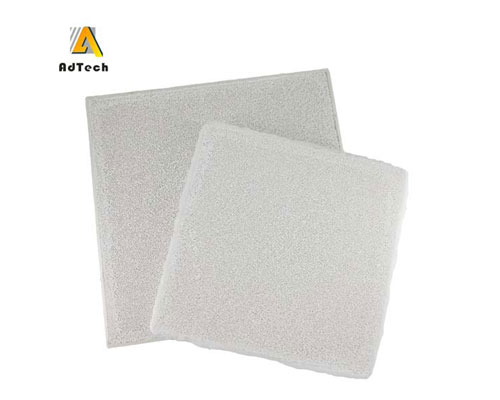In recent years, there has been an increasing demand for aluminum products such as aluminum cans for beverages and aluminum foils for packaging. Since the presence of solid impurities in the ingots used to produce these aluminum products can cause pinholes, wire breakage, or other similar defects, various attempts have been made to obtain refined ingots free of solid impurities. This ingot is produced from purified molten metal. Porous ceramics serve as a filter for molten metal, allowing molten metal to pass through to filter impurities.
AdTech provides porous ceramics foam suitable for use as a molten metal filter, which includes a porous ceramic body having pores that can pass aluminum fluid, and is characterized in that a metal layer covers the wall surface of the porous ceramic body. So that the fluid can flow through the hole while being in contact with the metal layer.
The porous ceramic body may include a sintered body of alumina balls or ceramic particles, a porous ceramic body (ceramic foam) having a mesh structure of three-dimensionally interconnected openings, and the like, and the ceramic form is preferably used as a filter material for molten metal.
When a metal layer is formed on the surface of the pore wall of the porous ceramic body, the porous ceramic body capable of allowing fluid to pass has good wettability with molten metal. Therefore, the porous ceramic structure in which the metal layer is formed on the wall surface of the hole through which the fluid can pass is suitable for use as a filter for molten metal, and can filter molten metal with high work and efficiency, and exhibits excellent Durability.
Since the deposited metal layer can allow the fluid to pass through the entire wall surface of the porous ceramic structure, when the molten metal flows through the pores, the affinity or wettability with the molten metal is significantly improved. Therefore, the porous ceramic structure can be suitably used as a filter for molten metal.
When the molten metal passes through the pores of the porous foam ceramic filter, its flow resistance is greatly reduced. Therefore, the time to introduce molten metal from the inlet of the filter can significantly reduce the material at the beginning of the filtration, and even if the initial pressure head is lowered, the filtration can start sufficiently. In addition, due to the improvement of wettability, the local flow of molten metal inside the filter is eliminated. In this way, under the synergistic effect between the increase in the effective passage area of the filter and the decrease in the flow resistance to the molten metal, the operating head can be reduced, while shortening the filtration time and increasing the processing capacity.

